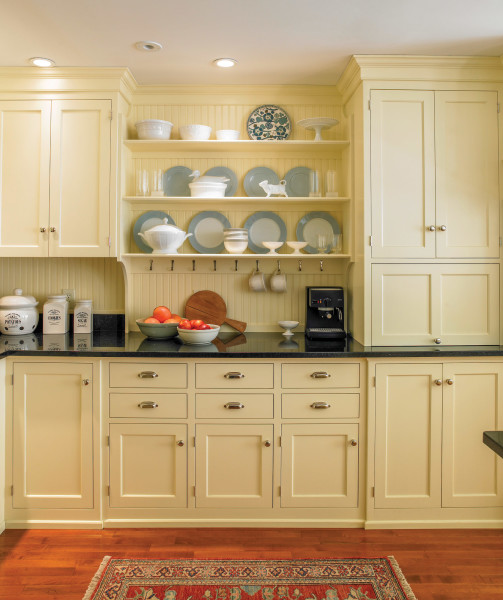
A custom kitchen by the Kennebec Company features period-inspired, furniture-quality cabinets fitted exactly to the space.
Decisions, decisions, and they’re all important. Kitchen cabinets set the tone for overall design, take a beating in use, and will affect resale value of the house. According to Consumer Reports, cabinets take 40% of the kitchen renovation budget. When it comes to a custom kitchen in a period home, the percentage is likely even higher.
The nomenclature by which cabinets are sold can seem contradictory. Three categories are generally accepted: stock, semi-custom, and custom. Within each, expectations and quality differ widely. An example: one maker’s “stock cabinet” may be of ¾” plywood and have dovetailed drawers, while another’s offers particleboard and MDF pieces that are hard to assemble. At the far end of the spectrum, a “custom kitchen” can come from a high-end cabinetmaking shop offering design services, a selection of fine woods and finishes, and a deep well of knowledge and experience . . . or it can be the local carpenter’s first such project.
Another trap is that while manufacturers of production and semi-custom cabinets are offering more choices and design upgrades due to demand, it doesn’t always mean the quality has gotten any better.
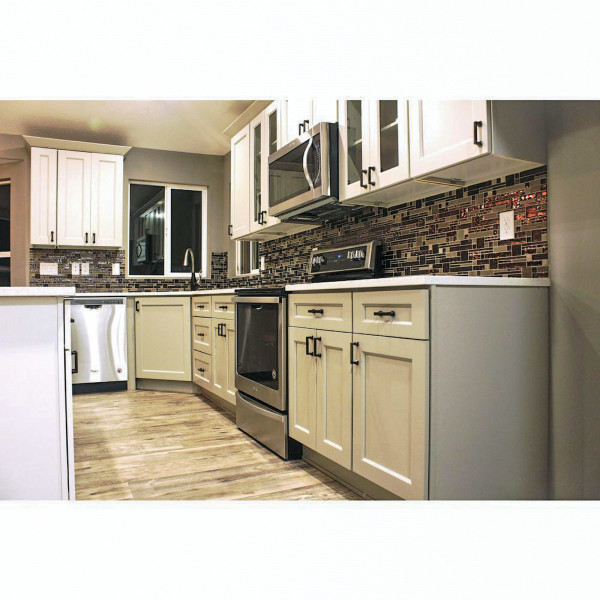
Kitchen made up of Krosswood Doors ‘Modern Craftsmen’ ready-to-assemble cabinets in White, sold at Home Depot.
Stock Cabinets
(aka economy, budget, builder-grade, production, modular, RTA) Sold in home-improvement stores, these may be “in stock” to take home, or available for quick shipment; they may be fully assembled or sold RTA, ready to assemble. Quality can be decent, but low cost is the primary goal for stock manufacturers. Most use frameless construction. Options are extremely limited. Standard cabinet widths are generally 12″ to 36″ or 48″, usually in 3″ increments, meaning filler strips will be needed when the fit isn’t perfect. Standard depth is 24″ for base cabinets and 12″ for wall cabinets. Assembly of many RTA cabinets turns out not to be a DIY job, so you may have to add labor cost to that of the cabinets. In any case, site-assembled cabinets won’t be as sturdy as a cabinet put together in a factory.
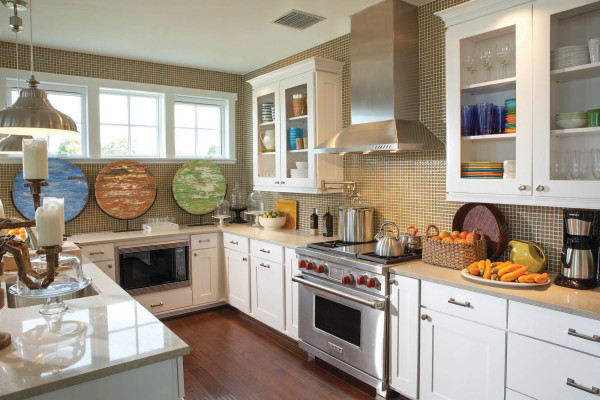
Cabinets by Wellborn fit in a transitional kitchen with a wood floor and stainless steel.
Semi-Custom/Mass Market
We’ve divided the semi-custom category. Home-improvement stores and some kitchen showrooms offer budget and mid-priced cabinets with more options than stock as well as minimal customization. Standard widths of 9″ to 48″ are offered in 3″ (occasionally 1″) increments, so again you may need fillers. You’ll find face-frame construction, but hardboard backs and laminate interiors are common. The mid-level range offers many options, sometimes including upgrades in quality. KraftMaid, for example, sold through Home Depot and other stores, has more than 65 different finish options and over 100 door styles. Lead time is usually about four to six weeks.
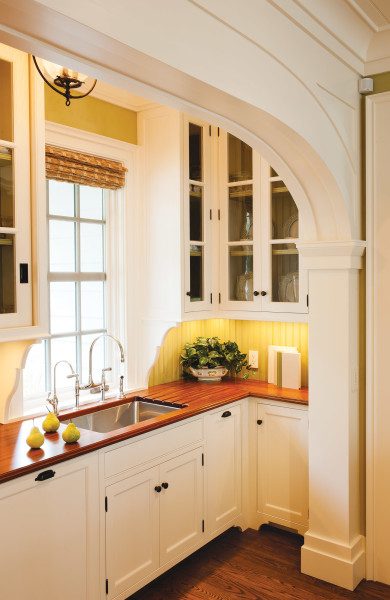
In a Crown Point Cabinetry kitchen, everything is custom, including the tall, glazed wall cabinets, the brackets, and the millwork arch.
Semi-Custom/Premium
These are cabinet lines sold by specialty makers or through kitchen showrooms. Many options and upgrades are available. Cabinets are made with plywood rather than particleboard, and width increments may go as low as ¼”, meaning less wasted space. A few semi-custom manufacturers offer different lines from budget to deluxe, with upgrades in construction quality clearly described on their websites.
Premium semi-custom cabinets are often a good choice, but you probably won’t find period-authentic details. Designs are somewhat generic to appeal to a broad customer base. An example of what’s not offered is inset cabinetry, where doors and drawers are inset into a frame. It’s difficult to craft because of tight tolerances, so most semi-custom manufacturers stay away from it, offering partial-overlay doors (rather than the common full-overlay) as a hedge. In old houses, though, inset cabinetry is more appropriate.
Every option and upgrade is added to the base price. Do your homework: the cost of semi-custom can creep into the fully custom price range, without the advantages of true custom.
What’s the decision process?
First may come cost: A ready-to-assemble IKEA kitchen can be as low as $2,000; the same average room in stock cabinets, $6,000–8,000; in semi-custom, $12,000–20,000; premium semi-custom, $20,000–30,000; custom, $35,000–50,000 and up. A large room costs more, as do added options. Upfront cost has to be weighed against value to the house; some years from now, nicked and rattling stock cabinets would be a liability for resale.
As for judging quality, read up and go to showrooms. You’ll soon see the difference between particleboard and plywood, plastic and metal, staples and dovetails, blemished finishes and quality control. A trusted kitchen designer can help you zero in on the best makers and best values, and a design that fits the space.
If you want inset doors and drawers, quarter-sawn oak, or a hand-brushed painted finish, you’re talking custom. If your taste is not quite so period-specific, semi-custom is an option, because such traditional designs as raised-panel white kitchens and Shaker doors are readily available. Start by writing down all the must-have features and options you need or would like. Then compare that list to what’s offered by semi-custom makers.
Custom work is often necessary in an old house with non-standard sizes and layouts and out-of-level floors. (If you are gutting the room, walls can be rebuilt to accommodate standard sizes.) On the other hand, your old house can help you save money. Say you have a separate pantry and you’ll be using an antique Hoosier and a vintage butcher-block on legs. The run of cabinets needed may be minimal, so keep the design simple and use production or semi-custom cabinets—or splurge on a smaller custom order.
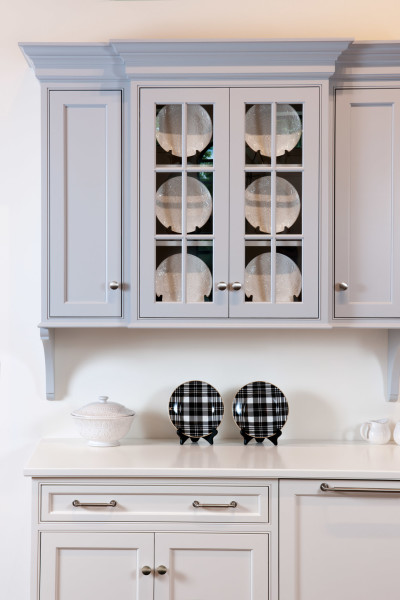
Crown Select is a premium semi-custom extension by custom maker Crown Point Cabinetry.
Custom Options Distilled
“Custom or semi-custom? I think Crown Select falls into a third category,” says Brian Stowell, the owner of Crown Point Cabinetry in Claremont, N.H., which recently introduced a more affordable option with a shorter delivery cycle.
Semi-custom cabinetry was readily accepted by people who wanted more options than stock provided, but couldn’t afford the leap to custom work. The market evolved, with clients becoming more sophisticated, and semi-custom cabinet factories have worked hard to increase offerings. Still, the premise of semi-custom is to offer a repeatable product made in a production facility.
Crown Select is the opposite: an extension from a custom cabinetmaker. Crown Select is built by the same craftspeople who create Crown Point custom kitchens. Construction differences are negligible and fall within custom-cabinet standards. Yet Crown Select cabinets for a full kitchen average $25,000 to $30,000, while Crown Point custom kitchens average $40,000 to $45,000. It’s not material or quality that makes the difference, it’s degree of customization. For example, “a Select client can’t get reclaimed material with decorative toe kicks and furniture ends and lots of storage features, and stay under $30,000,” Stowell says. “The reduction in our manufacturing cost comes from limiting endless customization, which is very costly and adds to the time frame.
“The beauty of Crown Select is that offerings meet the vast majority of criteria Crown Point clients have wanted, such as beaded and square-inset construction.” The durable factory finish is offered in 20 paint colors and 10 stained finishes—which also reflect the most popular custom choices.







